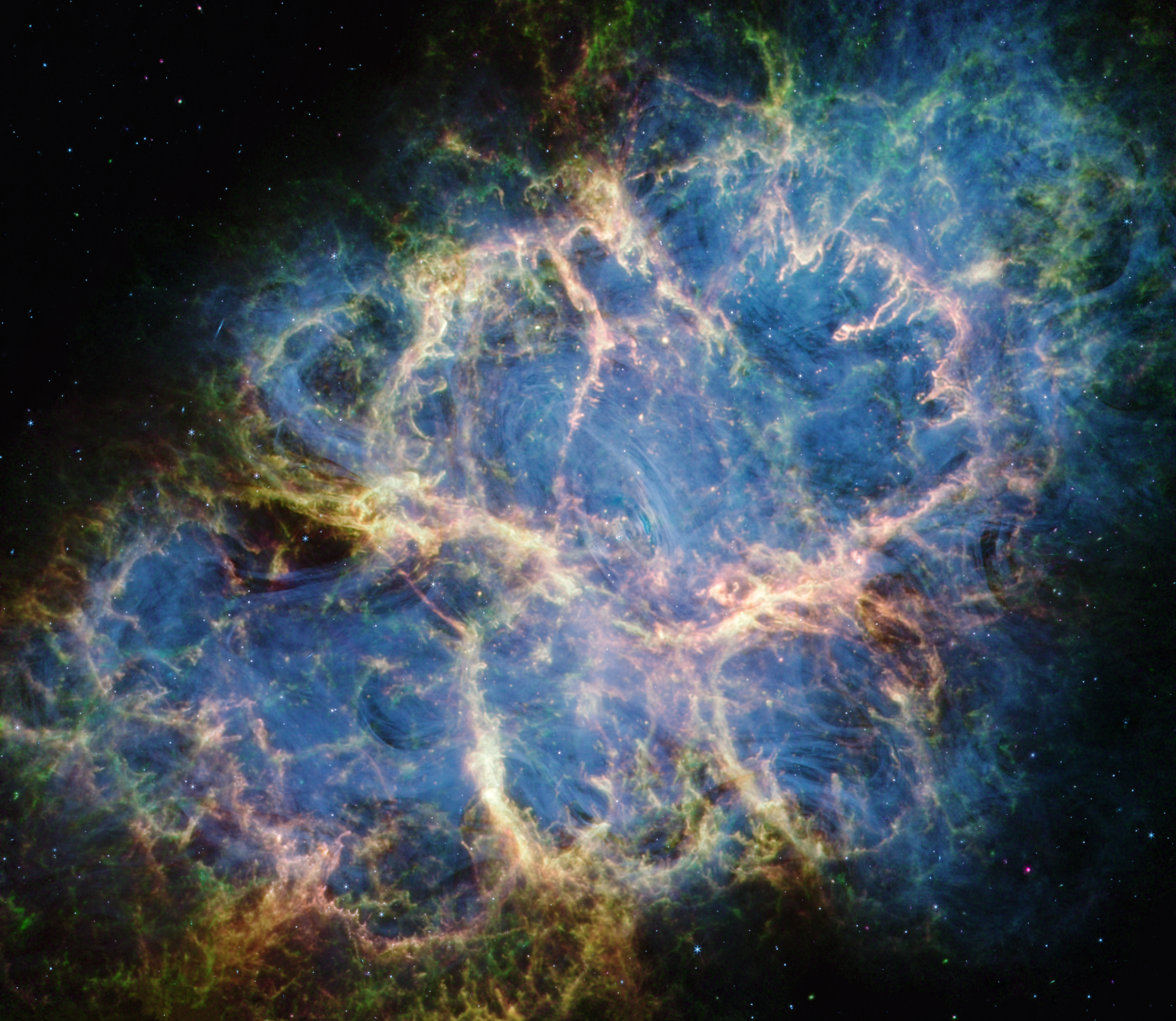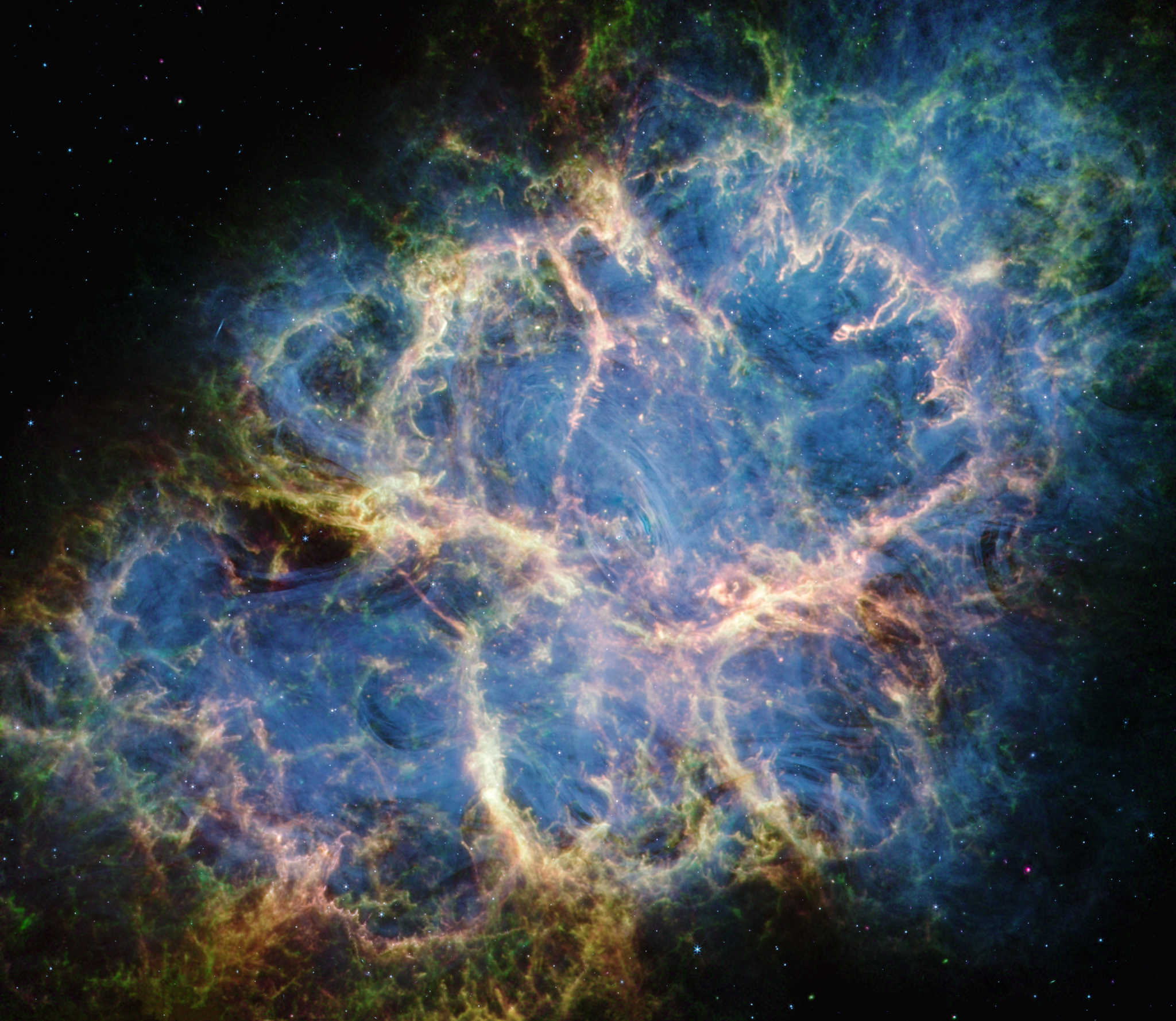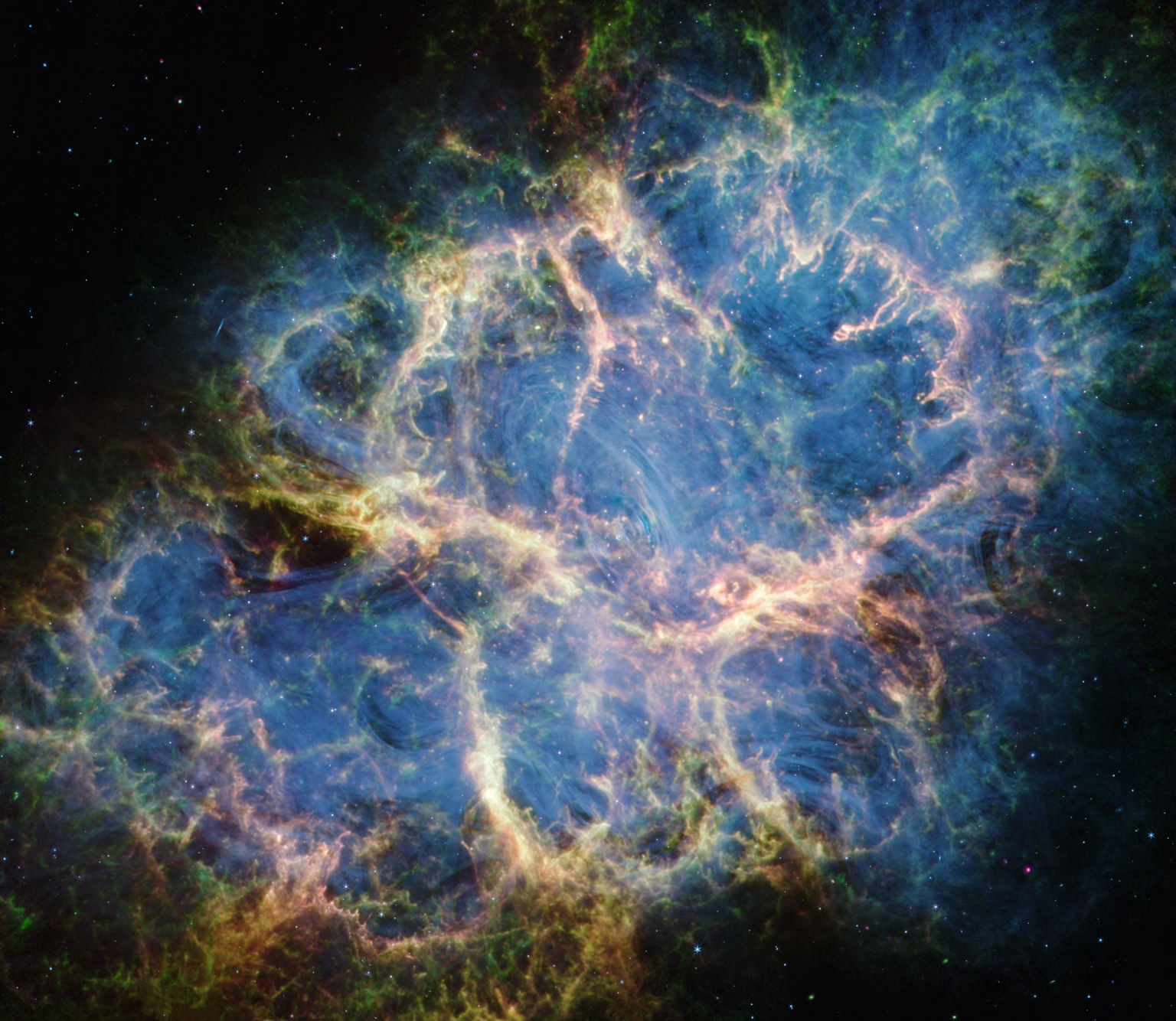Investigating the Origins of the Crab Nebula With NASA’s Webb

New data revises our view of this unusual supernova explosion.
A team of scientists used NASA’s James Webb Space Telescope to parse the composition of the Crab Nebula, a supernova remnant located 6,500 light-years away in the constellation Taurus. With the telescope’s MIRI (Mid-Infrared Instrument) and NIRCam (Near-Infrared Camera), the team gathered data that is helping to clarify the Crab Nebula’s history.
The Crab Nebula is the result of a core-collapse supernova from the death of a massive star. The supernova explosion itself was seen on Earth in 1054 CE and was bright enough to view during the daytime. The much fainter remnant observed today is an expanding shell of gas and dust, and outflowing wind powered by a pulsar, a rapidly spinning and highly magnetized neutron star.
The Crab Nebula is also highly unusual. Its atypical composition and very low explosion energy previously have been explained by an electron-capture supernova — a rare type of explosion that arises from a star with a less-evolved core made of oxygen, neon, and magnesium, rather than a more typical iron core.
“Now the Webb data widen the possible interpretations,” said Tea Temim, lead author of the study at Princeton University in New Jersey. “The composition of the gas no longer requires an electron-capture explosion, but could also be explained by a weak iron core-collapse supernova.”
Image A: Crab Nebula (NIRCam and MIRI)

Studying the Present to Understand the Past
Past research efforts have calculated the total kinetic energy of the explosion based on the quantity and velocities of the present-day ejecta. Astronomers deduced that the nature of the explosion was one of relatively low energy (less than one-tenth that of a normal supernova), and the progenitor star’s mass was in the range of eight to 10 solar masses — teetering on the thin line between stars that experience a violent supernova death and those that do not.
However, inconsistencies exist between the electron-capture supernova theory and observations of the Crab, particularly the observed rapid motion of the pulsar. In recent years, astronomers have also improved their understanding of iron core-collapse supernovae and now think that this type can also produce low-energy explosions, providing that the stellar mass is adequately low.
Webb Measurements Reconcile Historic Results
To lower the level of uncertainty surrounding the Crab’s progenitor star and nature of the explosion, the team led by Temim used Webb’s spectroscopic capabilities to hone in on two areas located within the Crab’s inner filaments.
Theories predict that because of the different chemical composition of the core in an electron-capture supernova, the nickel to iron (Ni/Fe) abundance ratio should be much higher than the ratio measured in our Sun (which contains these elements from previous generations of stars). Studies in the late 1980s and early 1990s measured the Ni/Fe ratio within the Crab using optical and near-infrared data and noted a high Ni/Fe abundance ratio that seemed to favor the electron-capture supernova scenario.
The Webb telescope, with its sensitive infrared capabilities, is now advancing Crab Nebula research. The team used MIRI’s spectroscopic abilities to measure the nickel and iron emission lines, resulting in a more reliable estimate of the Ni/Fe abundance ratio. They found that the ratio was still elevated compared to the Sun, but only modestly and much lower in comparison to prior estimates.
The revised values are consistent with electron-capture, but do not rule out an iron core-collapse explosion from a similarly low-mass star. (Higher-energy explosions from higher-mass stars are expected to produce ratios closer to solar abundances.) Further observational and theoretical work will be needed to distinguish between these two possibilities.
“At present, the spectral data from Webb covers two small regions of the Crab, so it’s important to study much more of the remnant and identify any spatial variations,” said Martin Laming of the Naval Research Laboratory in Washington and a co-author of the paper. “It would be interesting to see if we could identify emission lines from other elements, like cobalt or germanium.”
Video: Crab Nebula Deconstructed
Mapping the Crab’s Current State
Besides pulling spectral data from two small regions of the Crab Nebula’s interior to measure the abundance ratio, the telescope also observed the remnant’s broader environment to understand details of the synchrotron emission and the dust distribution.
The images and data collected by MIRI enabled the team to isolate the dust emission within the Crab and map it in high resolution for the first time. By mapping the warm dust emission with Webb, and even combining it with the Herschel Space Observatory’s data on cooler dust grains, the team created a well-rounded picture of the dust distribution: The outermost filaments contain relatively warmer dust, while cooler grains are prevalent near the center.
“Where dust is seen in the Crab is interesting because it differs from other supernova remnants, like Cassiopeia A and Supernova 1987A,” said Nathan Smith of the Steward Observatory at the University of Arizona and a co-author of the paper. “In those objects, the dust is in the very center. In the Crab, the dust is found in the dense filaments of the outer shell. The Crab Nebula lives up to a tradition in astronomy: The nearest, brightest, and best-studied objects tend to be bizarre.”
These findings have been accepted for publication in The Astrophysical Journal Letters.
The observations were taken as part of General Observer program 1714.
The James Webb Space Telescope is the world’s premier space science observatory. Webb is solving mysteries in our solar system, looking beyond to distant worlds around other stars, and probing the mysterious structures and origins of our universe and our place in it. Webb is an international program led by NASA with its partners, ESA (European Space Agency) and CSA (Canadian Space Agency).
Downloads
Right click any image to save it or open a larger version in a new tab/window via the browser’s popup menu.
View/Download all image products at all resolutions for this article from the Space Telescope Science Institute.
These findings have been accepted for publication in The Astrophysical Journal Letters.
Media Contacts
Laura Betz – laura.e.betz@nasa.gov, Rob Gutro – rob.gutro@nasa.gov
NASA’s Goddard Space Flight Center, Greenbelt, Md.
Abigail Major – amajor@stsci.edu / Christine Pulliam – cpulliam@stsci.edu
Space Telescope Science Institute, Baltimore, Md.
Related Information
Infographic: Massive Stars: Engines of Creation
Articles: Explore Other Webb Supernova Articles
3D visualization video : “Crab Nebula: The Multiwavelength Structure of a Pulsar Wind Nebula”
Sonification: Multiwavelength image of the Crab Nebula
Explore More: Crab Nebula resources from NASA’s Universe of Learning
Related For Kids
Interactive: Explore the Crab Nebula in multiple wavelengths
Activity: Create a stellar life cycle bookmark and bracelet
Activity: Flipbook resource for stellar evolution







